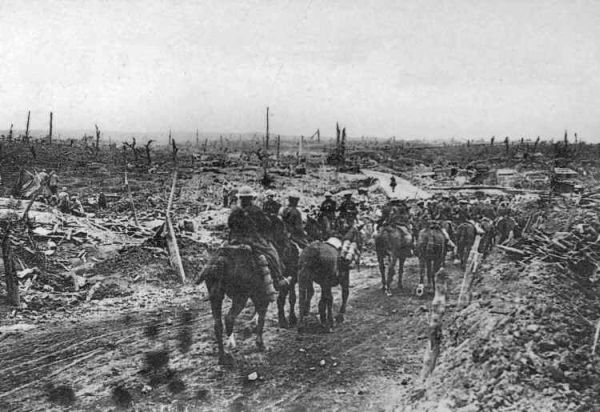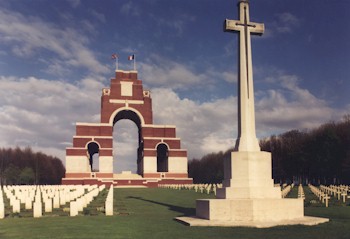|
|
| Home Topics Memorials Miscellany Transcripts References Family History Glossary Latest Beeston Blog About us | Site Search |
|
Luke Goodband was born in Aslockton, Nottinghamshire in 18812, the youngest of nine children of Francis (b. 1827-1908, an agricultural labourer) and Mary ( née Baker) Goodband. By 1900, Luke, aged 22, had left home and was working as a bricklayer's labourer, boarding in Colwyn Bay, North Wales. There he met Alice Maria Deeming who was then working as a domestic servant at the same lodging house. They married at St Editha Parish Church in Alice's home town of Polesworth, Warwickshire, on Christmas Day 1900. At the time of the census in the following March, they were still living in Colywn Bay.3. Over the next fourteen years the couple had seven children - Charles Walter (b. 27/11/1901), Margaret Lillian (b. 14/1/1904), Albert Edward (1905 - 1908), Ernest (b. 31/3/1908), Arthur Edward (b. 9/8/1909), Doris May (b. 11/1/1912) and Alice Martha (b. 19/5/1914) - and had, by 1909, moved to Beeston. By 1911, they were living there at 55 Windsor Street from where Alice had established a small grocery shop4 although Luke was working away, as a labourer, in Blyth in north Nottinghamshire5. Luke's Army Service Record has survived, so it is known that he enlisted at Nottingham with The King's Own Rifle Corps and joined 10th Battalion on 26 October 1914. The 10th (Service) Battalion had been formed at Winchester on 14 September 1914 and came under orders of 59th Brigade in 20th (Light) Division. Basic training was undertaken, first at Blackdown Camp in Surrey before going on to Witley Camp, also in Surrey, in February 1915, and then to Hamilton Camp, at Stonehenge, Wiltshire, in April 1915. The battalion, including Rifleman Goodband, landed at Boulogne on 21 July 19156. Sadly, his Service Record records that during his period of training, continuing after his arrival in France, he had issues for which he was disciplined on several occasions7. By the first half of 1916, 20th Division was in the Ypres salient where it played a supporting role during the German attack on the Canadians at Mount Sorrel. At the end of July and beginning of September, it was part of an operation to take the village of Guillemont. The Division was able to achieve this on the 3rd of September, 1916 but took heavy casualties. That morning, their line was positioned just to the west of the village and further north, running past the site of Guillemont station. The objective was to take the village, attacking from the north, west and south. and continue east. The attack had been postponed several times, partly due to poor weather. Assembly trenches were dug north of Guillemont Station to assist the attack to the north. At 6 am, a bombardment commenced and the infantry attacked at noon. The attack went well, although there were casualties, and the second objective (the eastern side of the village) was taken by 1.30 pm, although there was fierce hand to hand fighting within the village itself. Rifleman Goodband was amongst 39 other ranks and an officer reported killed during the action. Another officer and 23 other ranks were reported missing, 8 officers and 201 other ranks were injured. The totally destroyed village is shown in the photograph which follows. There is a memorial to 20th (Light) Division at a crossroads on the D20 leading east out of Guillemont8.  Rifleman Goodband's body was never identified and he is commemorated on the Thiepval Memorial to the Missing which now stands adjacent to the Leipzig Redoubt. The memorial was unveiled on the 1st August 1932 by the then Prince of Wales and is the largest British War Memorial in the world. Standing 150 feet high, it dominates the surrounding area. The memorial stands on a concrete raft 10ft thick, built 19ft below the ground, the solution to the problems of building over the warren of tunnels that formed the German second line. Designed by Sir Edwin Lutyens the memorial has sixteen masonry piers, where can be found, on the panel faces, the names of some 72,000 British and 830 South African soldiers who died and have no known grave, during the period starting in July 1915, when the British Third Army took over from the French, through the Somme battles of 1916, until 20th March 1918, the eve of the last great German offensive on the Somme. The focal point of the memorial is the Stone of Remembrance, which lies under the great arch and centrally between the piers, for which Rudyard Kipling chose a quotation from Ecclesiasticus, "There name liveth forevermore". Rifleman Goodband was posthumously awarded the British War Medal, Victory Medal and 1915 Star9. His widow had been left with six children, probably dependant on whatever she could earn from her small grocery shop and the earnings from her eldest children, including Charles who had started work at Beeston Foundry as a fettler in March 191610. She would have been grateful to be paid her husband's financial effects of £2 10s on 1 February 1917, his War Gratuity of £4 on 15 October 1919 and for the few photographs and letters that were returned to her11 although, by this time, she had married Amos Scott12 and moved to 38 Windsor Street where, for a short period, they continued to operate a shop. Footnotes 1The photograph of the Thiepval Memorial is from the Commonwealth War Graves Commission website. (http://www.cwgc.org) 2His birth was registered in Bingham Registration District in Q1/1881 (Ref 7b 439) 3Colwyn Bay, 1901 Census, 'Nelsonbrow', Princess Street, Piece 5289 Folio 158. Although Luke is recorded as married, Alice is recorded as unmarried, perhaps to keep her job as a servant. Joseph's siblings were Mary A (b. 1883), William Henry (c1885-1909), Emma Louisa (b. c1888) and Florence Beatrice (b. 1896). 4Beeston, Nottinghamshire, 1911 Census, Piece 20430 RD429 SD3 ED5 Sched 11 5Blyth, Nottinghamshire, 1911 Census, Piece 20244 RD427 SD2 ED3 Sched 27 6Details of the battalion formation, training and arrival in France are from The Long, Long Trail website - www.1914-1918.net/krrc.htm. 7Details of his disciplinary offences and sentences are given in his Service Record. These included a sentence of 4 days of the notorious "Field Punishment No 1 for improper conduct in November 1915. This involved being placed in fetters and handcuffs or similar restraints and attached to a fixed object, such as a gun wheel or a fence post, for up to two hours per day. 8Details of the battalion's involvement in the Ypres Salient generally and at Guillemont specifically are based on its war diaries, the War Memories website(www.wartimememoriesproject.com/greatwar/allied/battalion.php?pid=6483) and the World War Battlefield website( www.ww1battlefields.co.uk/somme/guillemont.html). 9Details from Luke's Medal Card - available on ancestry.com. 10Later, in November 1919, Charles joined the Royal Navy and is believed to have died of natural causes, while at sea, in 1931. 11Details from the "Army Register of Soldiers' Effects, 1901-1929" - available on ancestry.com. The record of the return of his letters and photographs is included in his Service Record. 12Alice's marriage to Amos Scott took place at Beeston Parish Church on 30 January 1918 and was recorded in Basford Registration District in Q1/1918 (Ref 7b 249). |
|
|||||||||||
|
|
|||||||||||||
